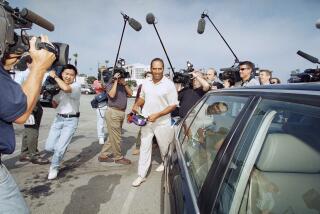Trayvon Martin case: Proof that the power is in the ‘sharing’
Last week, the fatal shooting of a black Florida teenager by a neighborhood watch captain had gained little media attention beyond the state’s newspapers, a smattering of mainstream media outlets and several prominent black journalists.
Today, the killing of 17-year-old Trayvon Martin is dominating the news in America, the latest example of how the fury of the social media machine and technology continue to transform the very definition of news, and the way that news is reported, written and delivered in this country and around the world.
“What we’ve seen in the past four or five days is that we have the power now,” said Michael Skolnik, editor in chief of GlobalGrind.com and political director to mogul Russell Simmons. Skolnik has been credited with helping the story gain nationwide attention.
“We don’t need a middle man or a middle woman,” he told The Times, referring to the mainstream media. “We can get our message out the way we want it. And we can decide what is important and what’s not important.”
An unusual mix of celebrities -- including actresses Alyssa Milano and Gabrielle Union, plus New Age leader Deepak Chopra -- is continuing to share the story, continuing to whip up national interest, continuing to demand justice. “Shame on Florida: Arrest George Zimmerman” for murder, tweeted Ice Cube.
“There are so many aspects of this story that make this a story that people want to share and want to tell,” social media guru Peter Shankman told The Times. “Fifty years ago, you could have shared it, but your reach would have been much smaller. You would have shared it with your friend, or at work, or in a letter to the editor. What’s new is everyone having the ability to do that at their fingertips.”
Martin was returning from a candy run on Feb. 26 when he was followed and confronted by George Zimmerman, 28. Martin had a cellphone, a bag of Skittles and an iced tea, police said. Zimmerman reportedly had a 9-millimeter.
Zimmerman has said he shot Martin in self-defense. The case has taken on racial overtones: Police have described Zimmerman as white; his family says he is Hispanic and have told the Associated Press that he is wrongly being depicted as a racist.
A Florida state attorney announced Tuesday that a grand jury will investigate the case. “I share in the desire of the family and the community to accurately collect and evaluate all the facts surrounding the tragic death of Trayvon Martin,” Seminole County state attorney Norm Wolfinger said in a news release. “The public is entitled to no less than a thorough, deliberate, and just review of the facts. We intend to honor that commitment.”
That development comes on the heels of Monday night’s announcement that the U.S. Department of Justice and the FBI would also investigate the shooting. Those decisions followed a day of growing protests and a social media firestorm, fueled by Twitter and Facebook and other social media.
Skolnik is responsible for a large slice of that furor, with a post that asked white America to sit up and take notice of the Martin case. It was headlined “White People, You Will Never Look Suspicious Like Trayvon Martin.” The story has more than 58,000 Facebook “likes” so far; it became a media accelerant, being shared again and again over a variety of platforms.
A Change.Org petition demanding Zimmerman’s prosecution has more than 576,000 online signatures so far.
Fanning the flames, too, have been phone calls made before and during the shooting.
Martin was chatting on his cellphone with a 16-year-old girl in the moments leading up to the shooting, and had complained to her that a strange man was following him, according to an ABC news report out Tuesday.
Law enforcement has also made public a phone call Zimmerman made to police identifying Martin as a black male walking with his hands at his waistband, and acting suspiciously. “This guy looks like he is up to no good. He is on drugs or something,” Zimmerman told the dispatcher, according to the Associated Press.
The neighborhood watch captain tells the dispatcher that he is following the youth, and was told: “You don’t have to do that.” He does so nonetheless.
Shankman said the case of Trayvon Martin shows that social media in many ways is just beginning to gain strength. He pointed to the online outrage that rained down on the Susan G. Komen foundation in the wake of the Planned Parenthood funding controversy, as well as the recent “Kony 2012” phenomenon.
“If we can’t share it, it almost didn’t happen,” he said. “When something like this happens, we want to be able to fight for justice. And the easiest way to fight is to share these stories, so people know what is happening. And we’re just getting better at amassing a movement.”
ALSO:
Tennessee bill could require publishing names of abortion doctors
New York chef promotes roaches, other insects as food of the future
No joke: New Jersey leads the nation’s anti-corruption efforts, study says
Join Rene Lynch on Google+, Facebook or Twitter
More to Read
Sign up for Essential California
The most important California stories and recommendations in your inbox every morning.
You may occasionally receive promotional content from the Los Angeles Times.










